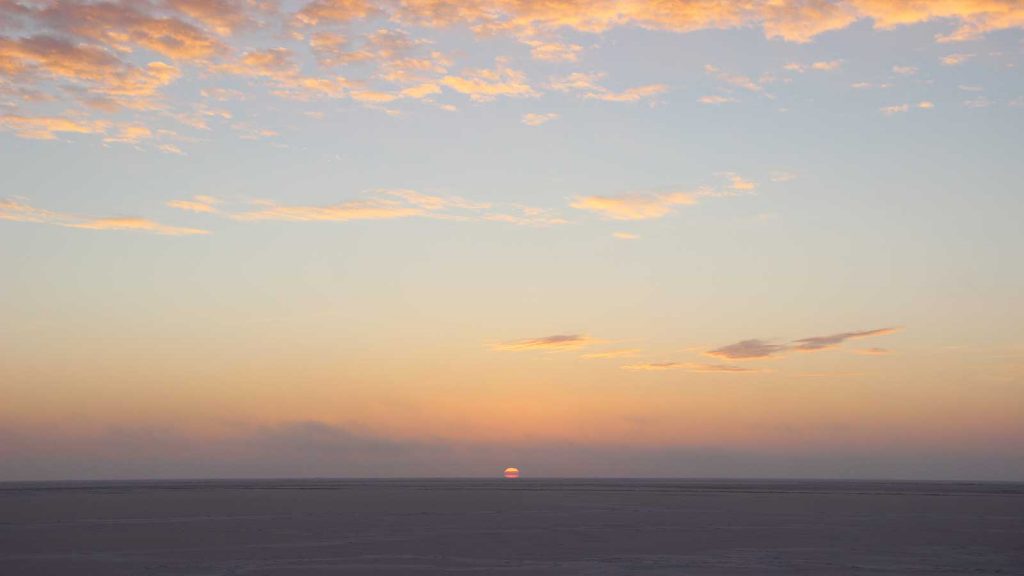
While it’s true that the sun never rises above the horizon anymore at this latitude, the predictions of no more sunrises or sunsets painted a much bleaker picture than what we’re experiencing. Happily, on those days whenever the sky is clear (last Friday and again—for those who were awake—Sunday morning) we have been treated to a gorgeous combined sunrise/sunset as the sun (at least a part of it) has appeared on the horizon before sliding back out of view again. Not a bad way to welcome in the first day of the second half of our cruise. (photo by Chris German, Woods Hole Oceanographic Institution)
Saturday was the midpoint of our cruise and the end of the beginning phase of our work. Suddenly, there is a new sense of urgency with the news that we need to leave station at the end of October 12 to be able to guarantee an on-time return in Bremerhaven, Germany on October 23. So, even though we still have three more weeks at sea, there are only 10 days left to make a difference. That made it a good time, therefore, for Antje to organize break to give everybody a chance to rest and recharge.
Aside for an hour of polar bear watch while an ice-station expedition was underway, I spent most of Saturday looking through the roughly 7,000 high-resolution black-and-white images that NUI collected on Friday’s dive. These were mainly for reconnaissance purposes so that I can begin to identify the most interesting spots to return to with NUI in ROV mode.
On Sunday, I got the chance to combine my notes from those observations with the best redox anomalies detected using Ko-ichi’s Eh sensor and, finally, where those points fell on the new high-resolution map Andrew produced using NUI survey data. But that didn’t happen until Sunday because no sooner had I completed working through all of the photographs than a call came out from the bridge: All crew and scientists were invited onto the ice for a pre-dinner excursion—with mulled wine. What a pleasant way to end the final day of the first half of the cruise.
After two hours of fresh air and relaxation we were ordered back on board to find a sumptuous barbecue dinner waiting for us. Even though the air temperature was much lower than what we experienced during our previous barbecue on the transit north, it didn’t feel so cold this time—apparently, we are becoming acclimatized!
After dinner, everyone danced and celebrated, but being a grumpy grandpa (and knowing how much data I still needed to sift through) I slipped away early in the evening. Louis was evidently of a similar mind and, while others partied long into the night, we enjoyed our free time in an equally enjoyable way by getting a decent night’s sleep. When you’ve lived as long as me, you don’t really need to hear a crowd sing “Come on Eileen” one more time. I was happy to be snug up in my bunk with The Cure.
Sunday was bright and clear and all was quiet aboard ship. We were conducting physical circulation studies with the ship underway, which meant no ice camps and no sign of most of the science party until lunchtime. Maybe they had gone to church?
In the NUI lab we were busy pulling all our data streams together and ended up with a great story: The chemical anomalies we saw on NUI Dive 14 last Tuesday were still there in the same place during Dive 15 three days later and 50 meters (160 feet) above the seafloor. In addition, the mapping we continued from Dive 14 showed that the gulley continued around the base of the summit of Karasik to the north and east. Finally, from our photographic survey, we not only identified bare rock exposed at the foot of the gulley but also that this was an area that also displayed signs of chemical anomalies down at the seafloor.
The signatures we have observed are far too weak to indicate any kind of conventional hydrothermal system, but they are not nothing. Clearly there must be something going on down there and someone really ought to go and take a closer look But who?
Ah, yes, that is what has also been going on this weekend. While Mike, Andrew, and I were working through all the data from the final NUI dive as an autonomous vehicle this cruise, Casey took the lead in converting our robot into its remotely operated configuration. That transformation should be complete in the next day or two, after which we will be ready to resume diving.
But between now and then, we are headed back to the deep vent site. Will tomorrow finally be the day that we find it on the seafloor? We have CTD tow-yo and an OFOS camera tow lined up back-to-back starting around midnight.

